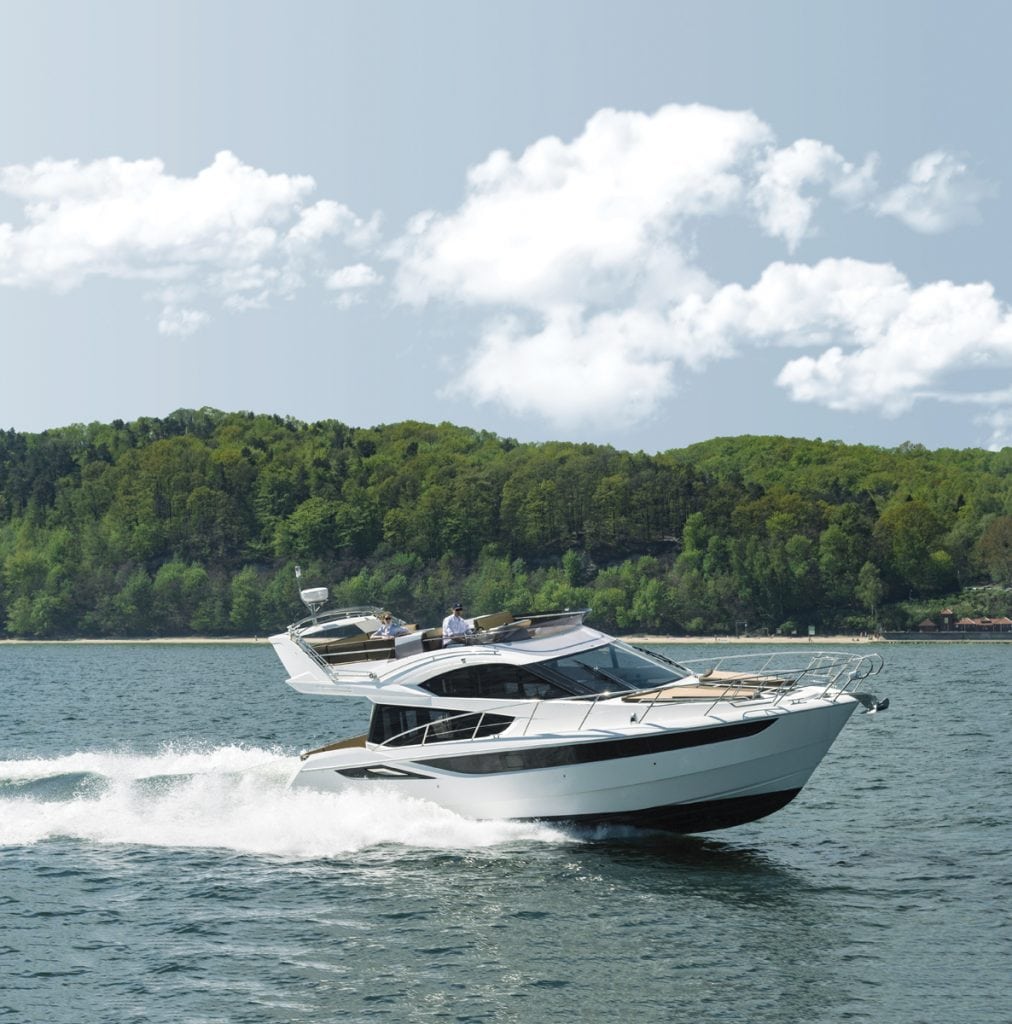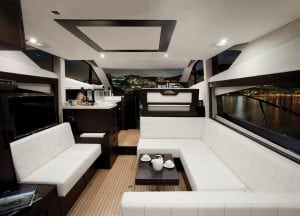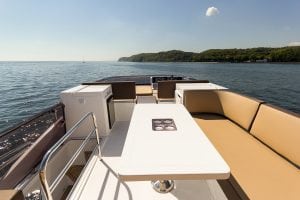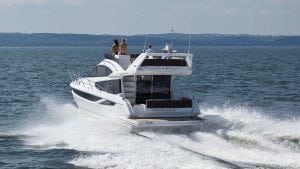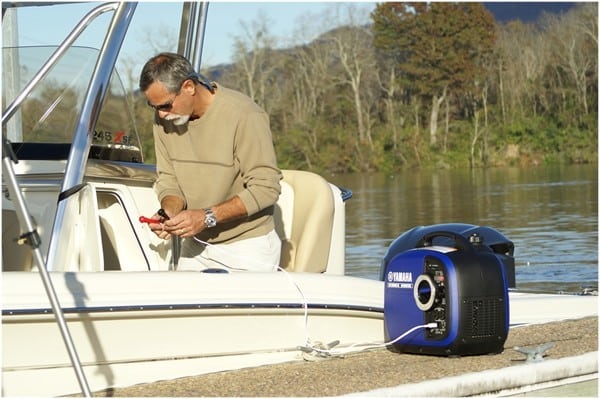Styling and finishes on the Galeon 420 Fly captivate the senses and stir the imagination
“What speaks to the American market about these yachts is their solid construction and lever use of space,” says Pete Zaleski of MarineMax. “But really, on first look, it’s the handcrafted wood details that get everyone’s attention.”
Indeed, the woodwork is the first thing that I have noticed on several Galeon Yachts now, and I’ve not been the only one to stop, trace my finger over the details and imagine an old-world craftsman laboring over this creation.
Galeon Yachts, a Polish boatbuilder, was founded in 1982, and in just a few decades, its lineup has grown to 30 models from 30 to 78 feet. MarineMax is the exclusive North American distributor of Galeon with representation on both coasts. I met up with Zaleski in California to take a spin on the Galeon 420 Fly and was pleased to take the helm on this zippy yacht. Despite my best efforts to knock her off balance, the boat stayed steady and sliced nicely through turns. With a V-shape hull at the bow and 16 degrees of deadrise at the transom, she carries her beam well forward to create interior volume for a spacious master stateroom and starts to get broad just a few feet back from the stem.
Since the water was flat, I looped back a couple of times onto our own wake to see how she’d handle the chop. Only once did we come down hard off the wake, but the 33,000-pound, hand-laid construction—which is solid below the waterline—just shook it off.
The optional teak-topped hydraulic swim platform was my first and very pleasant surprise. The seat that’s built into the transom slides aft about a foot over the swim platform to open up the cockpit for entertaining. Otherwise, it sits forward under the protection of the flybridge hardtop, creating adequate space on the platform to carry a dinghy or PWC.
A three-paneled glass door—two slide and accordion out to port while the third hinges open like a normal door—is an interesting arrangement that opens the entire aft area of the boat with nothing but a threshold to blend the indoors and outdoors. Continuing on this theme, the aft-most bench of the salon settee lifts and swivels out into the cockpit. It redefines convertible seating.
Steep steps lead from the cockpit to the flybridge, where an L-shaped settee wraps around a small table. The chef will have everything at hand to create a meal to enjoy alfresco with the optional galley module that includes a wet bar, refrigerator and an electric grill. A double seat at the helm is to starboard, and another companion bench is adjacent. A mini sunpad is to port just behind the wind deflector. The flybridge is a cozy space, but eight people still should have plenty of elbow room. A small double settee to port faces the U-shaped lounge on the other side—together they make up the salon. The galley and helm station are one step up. The inside helm dash is set on three levels with rocker switches low and to the left of the wheel, the autopilot and the 7-inch Volvo vessel control display in the middle, and a 12-inch Raymarine MFD up top just below eye level. Engine controls are outboard to the right along with the trim tab panel just below the driver’s window.
The helm seat is an ample bench with individual flip-up bolsters on both sides so that the driver can stand while the companion sits. The view forward—through an enormous single-pane, tinted, tempered-glass windshield—is like looking at a large movie screen projecting beautiful views
of the horizon.
The compact galley has a glass two-burner cooktop positioned at the center above a microwave with twin sinks to the left. Outboard at counter height is a small stowage locker fronted by a sliding, frosted Plexiglas door. Even with limited stowage space, there’s enough room on the countertop for all the tools a chef needs to prepare a great meal.
Curved stairs lead down from the galley to the accommodations level with three cabins and two heads. The good-sized master in the forepeak benefits from the wide beam that flows so far forward. Stowage options are ample between cabinets all around the perimeter, drawers under the large berth and a hanging locker to starboard. Elongated hull windows with inset opening ports, as well as an overhead hatch and skylight, illuminate the voluminous cabin.
A three-paneled glass door—two slide and accordion out to port while the third hinges open like a normal door—is an interesting arrangement that opens the entire aft area of the boat with nothing but a threshold to blend the indoors and outdoors. Continuing on this theme, the aft-most bench of the salon settee lifts and swivels out into the cockpit. It redefines convertible seating.
A small double settee to port faces the U-shaped lounge on the other side—together they make up the salon. The galley and helm station are one step up. The inside helm dash is set on three levels with rocker switches low and to the left of the wheel, the autopilot and the 7-inch Volvo vessel control display in the middle, and a 12-inch Raymarine MFD up top just below eye level. Engine controls are outboard to the right along with the trim tab panel just below the driver’s window. The helm seat is an ample bench with individual flip-up bolsters on both sides so that the driver can stand while the companion sits. The view forward—through an enormous single-pane, tinted, tempered-glass windshield—is like looking at a large movie screen projecting beautiful views of the horizon. The compact galley has a glass two-burner cooktop positioned at the center above a microwave with twin sinks to the left.
Outboard at counter height is a small stowage locker fronted by a sliding, frosted Plexiglas door. Even with limited stowage space, there’s enough room on the countertop for all the tools a chef needs to prepare a great meal. Curved stairs lead down from the galley to the accommodations level with three cabins and two heads. The good-sized master in the forepeak benefits from the wide beam that flows so far forward. Stowage options are ample between cabinets all around the perimeter, drawers under the large berth and a hanging locker to starboard. Elongated hull windows with inset opening ports, as well as an overhead hatch and skylight, illuminate the voluminous cabin.
The interior of this 420 was finished in matte black walnut wood with beautiful accents and intricate inlays. These unexpected details add elegance and a hint of that old world craftsmanship seldom seen on production boats. The details inside are noteworthy because Galeon manufactures many necessary component parts in-house, including stainless steel hinges, custom furniture and some high-quality fixtures. Galeon groups popular options into two packages, making it more cost effective as well as easier to tick off boxes of additional equipment.
“Galeon makes sure they offer lots of standard equipment, like a Fischer Panda 12kW genset, air conditioning, foam mattresses, and a bow searchlight,” says Zaleski. “They don’t parse out the options at crazy prices.”
The Comfort Pack includes electronics, a bow thruster, Glendinning Cablemaster for the shore power cord, flybridge canvas, and a 32-inch pop-up TV in the salon. The Luxury Pack adds to this with a foredeck sunpad, a drawer refrigerator on the flybridge, a 24-inch TV in the owner’s stateroom, and striped wood flooring in the salon. High-gloss finish is extra, but the standard matte adds a classy subtlety.
With the volume of yachts that Galeon launches every year, I’m sure its facilities in Straszyn, Poland, are uber-modern and highly efficient. Still, I can’t help but think of that master craftsman at work with chisel and plane, and wood shavings all around his feet. No matter how it gets done, the impressive results catch the eye and tickle the imagination.
By By Zuzana Prochazka, Southern Boating
October 2017

